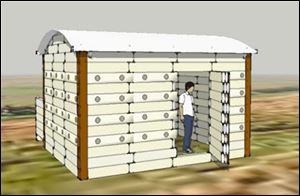
Local duo's idea a finalist for homes in Haiti
8/11/2010
A drawing shows the construction of a LyteBeam home.
Picture corrugated cardboard blocks that actually are made of plastic.
Then imagine a small home built with the blocks and throw in innovative features - solar-powered lighting, a rainwater collection and storage system, and vegetables literally growing from the walls.
That concept - dubbed the LyteBeam Home - has been selected as one of 40 finalists in a worldwide competition seeking alternative forms of permanent housing for Haitians displaced by January's earthquake.
Perrysburg-based Missions International of America submitted the idea for the government-sponsored "Building Back Better Communities" competition and expects to build a prototype of the home in Haiti in October.
"When you realize they don't have water available, even dirty water, without long walks, no way to grow plants because they have no water, and no way to store water, I think we designed a really remarkable home with a whole new way of looking at shelter and construction and the environment," said Rick Kramer, a design engineer who created the house and member of the Missions International board.
The 10-foot-by-15-foot home is waterproof, hurricane-proof, earthquake-proof, and Mr. Kramer said, "voodoo-resistant" as well.
"The voodoo-practicing people need their house closed up at night," he said, adding that the home has windows that can be closed and secured.
Dr. Jay Nielsen, president of Missions International, said that as soon as he returned from a 14-day visit to Haiti after the earthquake, he knew there would be a need for housing options. Mr. Kramer got started on a design, but they weren't sure how to get into the market.
Just a few weeks ago, Dr. Nielsen's wife, Jan, found the competition online. The deadline for entries had just passed.
"We found this thing an hour after it closed, and we were just heartbroken because this was our big shot," Dr. Nielsen said. "Then I looked up in the upper right corner and saw that the deadline had been extended two weeks.
"Most people who submitted grants probably had been working on it since January with a team of 20 people and a million-dollar budget. We were just two guys working on this after work for two weeks."
Dr. Nielsen said the requirements and specifications for the prototype houses were vague, but he and Mr. Kramer figure their concept house was attractive because of its low cost - $1,300 for a basic model and $2,600 for a "deluxe" model that includes solar power, furniture, stove, plumbing, and hydroponic gardening capabilities.
Mr. Kramer said the LyteBeam Home is easy to assemble and lightweight, and it can be disassembled, moved, and reassembled. The rainwater collection and water storage system also was likely appealing as well as the house's ability to grow plants in "in-wall embedded pots" that are individually irrigated.
While the home may seem rudimentary to most Americans, Mr. Kramer said a visit to Haiti this summer convinced him many of its features would make an enormous improvement in the Haitians' quality of life. It was his first trip to the poverty-stricken country.
"When I did finally visit, I realized they need to regain their dignity," he said. "I've never been so embarrassed to see so many people showering out in the middle of everything, bathing their babies ... It was good to see what they do have and don't have, especially what they don't have."
Missions International of America plans to have examples of the house's beams, construction, drip irrigaton, and solar power system at its annual fundraiser, Helping Hands for Haiti, from 2 p.m. to 8 p.m. Sunday at Grace United Methodist Church, 601 East Boundary St.
Contact Jennifer Feehan at:
jfeehan@theblade.com
or 419-724-6129.